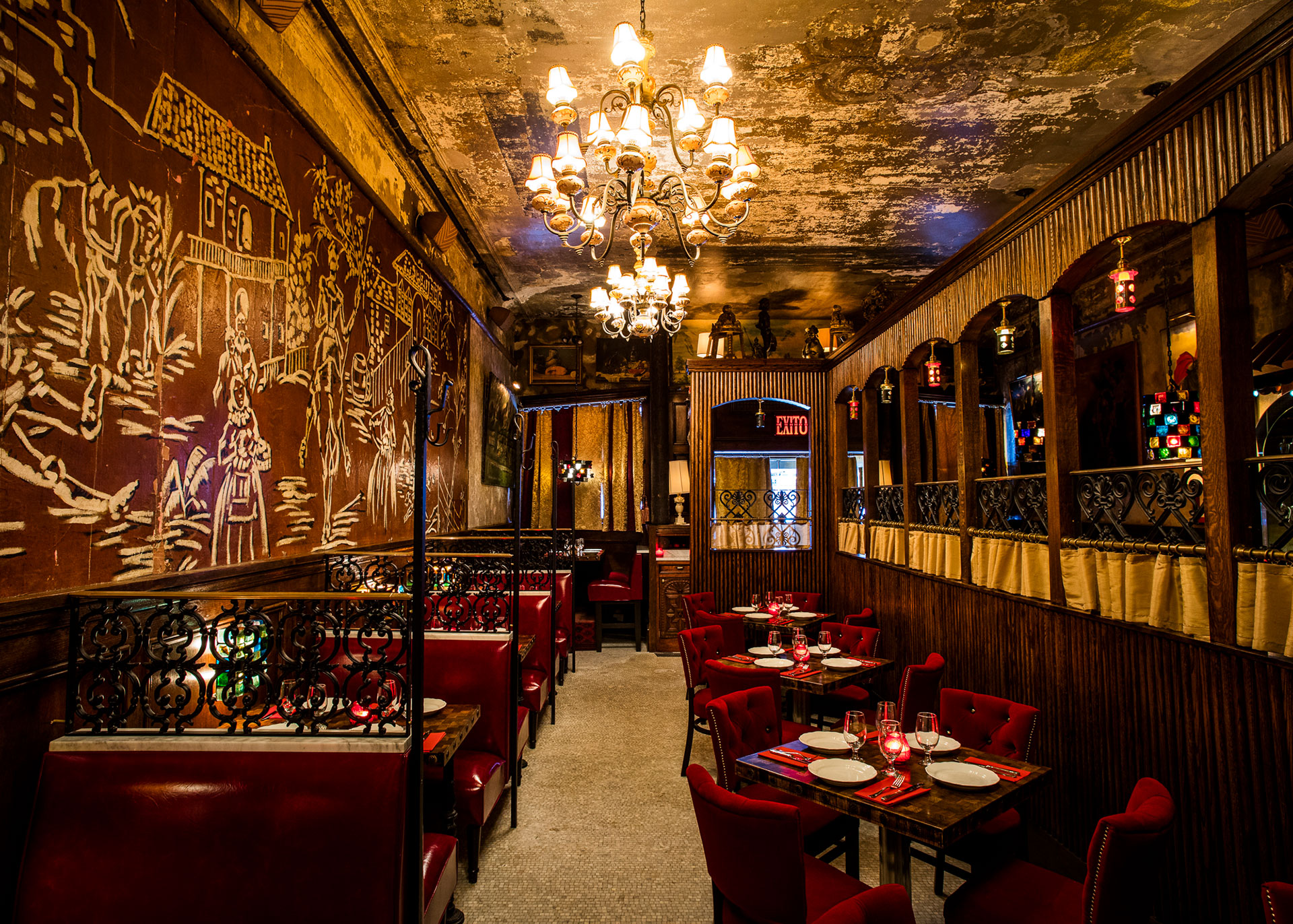The Hotel Chelsea is one of those interesting thought experiments about the good old days in New York City — about wishing you had been there back then, back when it was all happening, back before everything changed, back before the banks and the Starbucks and the pilates studios camped out on every corner. On the surface, the history of the Chelsea reads like a fairytale of sorts, an almost too perfect confluence of place and personalities. Yet while many of the guests were glamorous, the hotel itself, in its heyday, wasn’t exactly a bastion of first-class accommodation. Some rooms, like the one Leonard Cohen rented during his fling with Janis Joplin — immortalized in the song “Chelsea Hotel #2” — were shabby and dated even by 1968 standards, and that didn’t change much in the intervening years.
None of that has ever mattered, though. The Chelsea was a “house of infinite toleration” where the maids rarely ran their vacuum cleaners, as Arthur Miller explained in his essay, “The Chelsea Affect.” Residents got out of each room what they put into it, making a DIY wonderland from the bones of the brilliant old building. The spunk and soul of its inhabitants made the hotel legendary, just like Soho lofts in the ’80s, Village walkups in the ’60s, or Williamsburg warehouses in the ’00s. To want to revisit these periods is to want to be young again, when we’d happily concede certain comforts in exchange for action and intrigue and the promise that we’d have absolutely no idea what might happen next.
But do we really want to go back? Or do we just want to be a tourist to the good times, skipping all the boring bits and unpleasant parts? Because while the Hotel Chelsea is the place where Bob Dylan stayed up for days to write “Sad Eyed Lady of the Lowlands” for his new wife Sara, and where Miller resurrected the ghost of Marilyn Monroe for his play "After the Fall," and where Patti Smith came of age with Robert Mapplethorpe, it’s also the place where Dee Dee Ramone lured heroin addicts like a magnet, where Dylan Thomas spent his last few torturous days, and where Nancy Spungeon bled to death from a stab wound to the stomach. We'll ask again. Do we really want to go back?
These are the questions the new Chelsea asks. Not explicitly, but simply because the iconic property has been irrevocably changed — reinvented by acclaimed hoteliers Sean MacPherson, Ira Drukier, and Richard Born as the kind of impossibly cool luxury boutique hotel in which they specialize. To call this new direction controversial is an understatement. There were plenty of folks (most notably the Chelsea’s long-term tenants) who wanted the hotel to remain as it was, accessible to a whole new generation of artists. That’s a noble goal worth supporting — though it’s not clear it was ever in the cards. New York is different, and even the same old places aren’t the same. For NYC in the early 21st century, the Chelsea’s evolution is an expected one, similar to its shift in the early 20th century from co-op housing to long-stay hotel.
In an ironic but somewhat unavoidable twist, that’s the era the owners most represented here. Their Hotel Chelsea does go back — back before the celebrity parades to a time that recalls its founding more than its bohemian later days. It leans on its pop mythology, but it doesn’t depend on it. It’s a new beginning for the hotel, a fresh chance to create a hundred more years of cultural history. Precisely because of the context, the Chelsea is one of the most celebrated hotel openings in decades.

A Straight Line from Mark Twain to Madonna
It's a historic restoration that's sorely needed on the American hotel scene — especially when you compare it to, say, the kind of hotels you find with ease in France or Italy. This country doesn’t yet have as many storied, generational hotels as countries where centuries-old estates come with historical epochs and guest lists that date back to kings and queens. Here, the most famous hotels are notable less for their age or nobility and more for, let’s face it, the untamed behavior of their most notorious guests. The Chelsea combined that libertinism with an incredible track record of artistic achievement. In addition to the output from Dylan and Miller, Thomas Wolfe wrote “You Can’t Go Home Again” at the Chelsea. Jack Kerouac wrote parts of “On the Road” there. Warhol filmed there, and Arthur C. Clarke worked on the screenplay for “2001: A Space Odyssey” there. And the list goes on.
To follow the hotel’s history is to draw a line in American pop culture from Mark Twain to Madonna — all of whom stayed at the Chelsea, many of whom spoke about it in terms sometimes glowing, sometimes apocalyptic, always in a way that painted a picture of a vibrant and creatively fruitful community that jumped from storied epoch to epoch. The last decade was not one of them. After a sale in 2011 and a round of hot-potato between owners, the Hotel Chelsea was a run-down landmark building with a 120-year tradition that had nearly stopped cold. In 2022 — under the same stewardship as longstanding favorites like the Maritime and the Bowery — it was without a doubt the most exciting brand new old hotel to open in New York City. Just two years later, its lived up to its incredible expectations, earning a coveted MICHELIN Key.
Not everything has changed at the Chelsea. The lobby, less chaotic than it once was, is still a mélange of modern and abstract artworks, gifts from guests and tenants over the years who famously paid with paintings when cash was short. That carries through upstairs, where you won’t find William Burroughs mumbling around the hallways, but you will find rooms bedecked with art from the hotel’s endless collection. They retain the longtime spirit of the hotel but with a bit more intention to the interior design.

Today's Hotel Chelsea: An Eclectic Apartment Building
Room types span from the modest Petite Chelsea to the sprawling Two Bedroom Suite. But within both — and all accommodations in between — is a standard style that gushes bohemian, with purple-tinged rugs and leopard-print chairs to go with soft headboards decorated like a canvas splattered with paint. The drapes aren’t ripped to shreds like they may have been in the era of the Sex Pistols, but they’re peppered with little holes the size of pennies in an artful allusion to rock-star destruction. The effect is a beautiful, dappled light that gently enters your room at sunrise.
It all adds up to a Hotel Chelsea that feels more like an eclectic, New York apartment building than one of its trendiest hotels. Rise to the rooftop and you’ll even find a true moment of zen, a gorgeous penthouse spa with its own terrace garden.
That’s from floor two and up. On the first floor: expect less calm. The Lobby Bar is an undeniably sceney hotspot, the kind of place you’ll spot a woman in a fur coat step out for a cigarette in-between sips of a signature martini. Cafe Chelsea is the more casual, French-American bistro, and El Quijote is the historic restaurant (first opened in 1930), still with its long windmill mural and Spanish menu.
Locals will want to make reservations at any of these spots, lest they’re turned away nearly any weekend night. But hotel guests have the good fortune of priority access. The Hotel Chelsea puts aside a few tables for guests who call down for a last-minute accommodation.
Between everything on offer, the new Hotel Chelsea has brought this little stretch of 23rd between Seventh and Eighth roaring back, making it as fashionable as its ever been before. And of all the new amenities, it’s the reworked iron balconies, wrapping around the iconic red brick facade, that provide a poetic way to understand the new old hotel. Original balconies were known for their missing dividers — guests’ pets could wander from room to room. Today’s hotel prides itself on those wonderful outdoor spaces, while hoping to put up some semblance of boundaries between them. It’s a tidy metaphor — if not quite worthy of Dylan — for the new era at 222 W. 23rd.
Book the Hotel Chelsea with The MICHELIN Guide →






Photography by Annie Schlechter and Eric Medsker



















